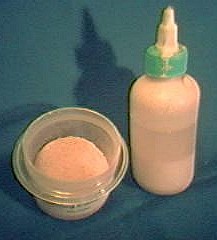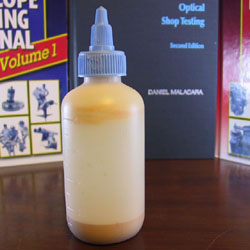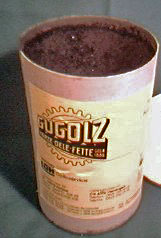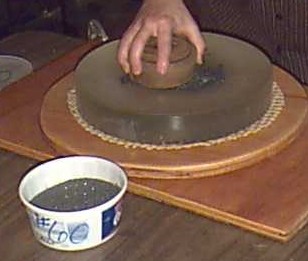|
||||||||||||||||||||||||||||||||||||||||||||||||||||||||||||||||||||||||||||||||||||||||||||||||||||||||||||||||||||||||||||||||||||||||||||
Reference Information for
|
||||||||||||||||||||||||||||||||||||||||||||||||||||||||||||||||||||||||||||||||||||||||||||||||||||||||||||||||||||||||||||||||||||||||||||
|
Note 1: U.S. Department of Commerce Commercial Standard CS 271-65, #8 through #240. |
Grit Sequences
There is no real magic or fixed sequences in selecting grits; the idea is to start rough grinding with a suitably coarse grit to remove glass quickly and get close to your desired sagitta (depth of curve). You then move to successively finer grits to get a good spherical section and smooth the surface in preparation for polishing. Mirror makers who use grinding machines tend to use fewer grits with bigger jumps in sizes;
Starting Grit Size
| Mirror Size | Starting Grit |
|---|---|
| 6" and smaller: | 80 grit |
| 8" to 16": | 60 grit |
| 16" and larger: | 40 grit |
These choice are a compromise between speed and volume of glass to remove and the amount of work needed to smooth out the surface a coarser grit will produce.
Typical Grit Sequence
For hand grinding, the coarse grit sequence of 40, 60 , 80, 120, 220 is typical (start at the grit size appropriate for your mirror diameter as given in the section above). Silicon Carbide is used almost exclusively.
Fine grit sequences vary more, and are often adjusted based on the supplies at hand. Starting at 32 Micron (320 Grit) you might use:
You can see these sample sequences try to step down the particle size by less than half the previous size. If you use bigger jumps in size, you need to work longer in smoothing the surface from the previous grit. Often Silicon Carbide is used initially, and when moving to 32 or 25 micron the less aggressive Aluminum Oxide used for the remainder of the sequence, as it will produce a smoother finish.
Some amateurs prefer to use a minimum of grit sizes (minimizes cleanup between grits time and cost of supplies). Mel Bartels, a well respected west coast amateur, recommends on his Large, Thin Mirror Grinding web page starting with something between 30 and 60 grit, and then 120, 220, 500 (=25 micron) and finishing with 9 micron. This is just a 5 grit sequence, as opposed to 8 to 10 for the more traditional sequences usually recommended for novices. You will spend more time at each grit size, but you will still be successful.
Polishing Compounds

Cerium Oxide: Powder & mixed
with water in a squeeze bottle.
Polishing Compounds are used with a Pitch Lap to polish and figure a mirror. The polishing compounds embed themselves into the pitch to make an abrasive surface that, due to the characteristics of the pitch, can conform to the glass surface and produce optical quality surfaces.
Cerium Oxide (CeO2) is the polishing compound of choice for most ATM's today. It works fast and is easy to use, with little mess, and is the compound supplied with most commercially available mirror kits. Pink in color, it is applied to your work from a squeeze bottle in a water suspension. It cleans up easily. Typical Cerium Oxide particle sizes are about 3 microns.
Zirconium Oxide is one of the modern slow polishing compounds, being softer than Cerium Oxide but retaining it's ease of use. Some people like to use this compound for figuring, where slow, controlled action can be an asset.
Red Rouge is the traditional ATM polishing compound, a form of Iron, or Ferric, oxide. It is soft and 2x to 3x slower in action then modern compounds such as Cerium Oxide, but many feel it produces the smoothest optical surface of all. It's ability to stain your clothes is legendary; careful handling is mandatory. Black Rouge has also been used; it has a slightly smaller particle size.
Barnesite, a dark red mineral compound, was a popular polishing compound you may run across if you work with a group that has stockpiled supplies. It is no longer being produced in the United States.

Cerium Oxide Mixture: 1 Tablespoon of CeO2 and 8 Tablespoons of Distilled Water fill a 4 oz. plastic bottle. The CeO2 has settled to the bottom, while the top of the water is at the orange smudge near the top of the bottle.
Mixing Cerium Oxide
While it is possible to buy pre-mixed CeO2, it is typically available only in quantities that are too large and expensive for the individual ATM. Usually, CeO2 is supplied to the ATM in dry powder form. To be used, it must be mixed with clean water to form a slurry. In the Northeast United States, you can easily buy a gallon of distilled water at large drugstore chains for a few dollars, and this is what I use to mix my polishing compound.
A thin mix works best. Many people think that a thick mix will work better, but it is only the CeO2 embedded in the lap that does the real work - everything else just acts as a lubricant, forming a layer between the embedded CeO2 in the lap and glass, preventing or slowing polishing. So keeping your polishing mix thin works best. An 8:1 ratio of water to powder (by volume) will yield a good thin mix -- about the consistency of skim milk. Measure the ingredients into a clean container that can be sealed, and shake to mix. Also be sure to shake your dispensing bottle a each time before using it, as the Cerium Oxide will settle out if left undisturbed.
Small plastic squeeze bottles are ideal for mixing and dispensing CeO2 mixture. The bottle in the picture was purchased at a Target store as part of 4 bottle set sold in the pharmacy department for travel use. The set cost less than $2.00, and one other bottle in it was suitable for use with aluminum oxide slurry.
Pitch

A 1 kg can of
Gugolz #64.
Pitch is a material that is so viscous that it appears to be a solid at room temperature; yet it can flow with time (faster when heated or under pressure) to confirm to the surface of your mirror and ensure a good polish. (A fun look at how slowly pitch flows from The University of Queensland) There are a wide variety of pitches available, but the two most common used by amateurs are Burgundy Pitch (yellowish brown) or Gugolz (black).
The goal is to get a pitch that is not so hard that it does not flow enough to make good contact, and not so soft that it flows too much (resulting in clogged channels and often Turned Down Edge). In general, for normal room temperature polishing, use Medium Burgundy or Gugolz #73 in the summer, Soft Burgundy or Gugolz #64 in the winter. You can mix pitches within the same family -- many of the Springfield Telescope Makers use a 50% / 50% mix of Gugolz #64 and #73 for non-summer work in heated rooms. See the discussion about ambient temperature on the Polishing Page under Temperature & Humidity.
The pitch lap (a pitch coated tool) is used for polishing and figuring. It works by conforming to the mirror
surface on a fine scale, and polishing agent embedded in it's surface abrades the surface to polish and then
figure your mirror.
|
|
|||||||||||||||||||||||||||||||||||||||
How Much Will I Need?
The table below can be used as a rough guide in obtaining the grit, polish and pitch necessary for a small mirror project. Be aware that buying small quantities of is often difficult and expensive, and the first time mirror maker usually does best to purchase a mirror making kit which includes the necessary set of abrasives and pitch. Also be aware that abrasive usage varies widely with skill and work habits -- the table lists generous quantities for most people, as there is nothing more frustrating than running out during your project. Do not be concerned if a mirror kit contains substantially smaller amounts, particularly with the finer grits -- in practice, a little goes a very long way.
| Material Needed (in Pounds) | Mirror Size in Inches | ||||||
|---|---|---|---|---|---|---|---|
| Material | Size | 4.25 | 6 | 8 | 10 | 12 | 14 |
| Silicon Carbide |
#60 | - | - | 1.00 | 1.50 | 1.50 | 2.00 |
| #80 | 0.50 | 0.50 | 0.75 | 1.00 | 1.00 | 1.50 | |
| #120 | 0.25 | 0.25 | 0.50 | 0.75 | 1.00 | 1.50 | |
| #220 | 0.25 | 0.25 | 0.50 | 0.75 | 0.75 | 1.00 | |
| Aluminum Oxide |
25 Micron | 0.25 | 0.25 | 0.25 | 0.50 | 0.50 | 0.75 |
| 15 Micron | 0.25 | 0.25 | 0.25 | 0.25 | 0.50 | 0.50 | |
| 9 Micron | 0.25 | 0.25 | 0.25 | 0.25 | 0.25 | 0.50 | |
| 5 Micron | (0.25) | (0.25) | (0.25) | 0.25 | 0.25 | 0.50 | |
| Cerium Oxide | ~3 Micron | 0.25 | 0.25 | 0.25 | 0.50 | 1.00 | 1.25 |
| Pitch | Medium | 0.50 | 1.00 | 1.00 | 1.50 | 2.00 | 3.00 |
Note that many mirror makers do not use 5 Micron grit on mirrors under 8" - they feel it is not necessary and that there is increased risk of getting a scratch. No time is saved, as you will have to polish longer to compensate.
Safe Handling & Storage
Contamination of your grit or polish with large particles that will scratch your mirror is a constant threat. Grit and polish must be handled and stored carefully to prevent contamination. Also pay attention to your clothing and fingernails, two other favorite places for contaminates to hide.
If your grit came in sealed containers, leave them sealed until you need to use them. If you have large quantities of grit or polish, transfer a small amount into a working container, to minimize the risk of contaminating the whole batch.
Always keep you material in sealed containers. We recommend double sealing: Use a both a hard sided container and plastic bag. For small quantities of grit, a plastic bag with a twist tie inside a yogurt or cottage cheese container works well. Zipper type plastic bags don't seem to work as well, as the grit can jamb the zipper. Zipper bags as a second seal to hold a hard plastic container are fine, as there is no direct contact with the grit. Double or triple plastic bagging is also workable (but much less convenient to get at the grit when grinding).
If you must work with several grit sizes at the same time, always start with the finest grits and work towards the coarsest grits. Fine particle contamination of a coarse grit will never be noticed; but single coarse particle in your fine grit will produce a terrible scratch!
Store your grits carefully. If you place your supplies on shelves, store the finest material at the top and the coarsest at the bottom. Should a stray particle fall, it will be a fine particle safely falling into a coarser grit.
Back to the ATM Index Page


